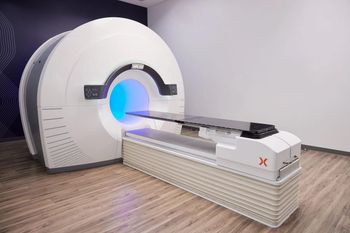
Siemens’ digital mammography unit gains accreditation
The last of the four FDA-approved full-field digital scanners, Siemens Mammomat Novation DR, has gained American College of Radiology accreditation. The FDA granted the ACR the right in 2003 to accredit the other three digital mammography machines approved for sale in the U.S.: GE Senographe 2000D, Fischer SenoScan, and Lorad Selenia. The ACR accredits about 95% of mammography equipment in the U.S., while the state handles the accreditation process in Texas, Arkansas, and Iowa.
The last of the four FDA-approved full-field digital scanners, Siemens Mammomat Novation DR, has gained American College of Radiology accreditation. The FDA granted the ACR the right in 2003 to accredit the other three digital mammography machines approved for sale in the U.S.: GE Senographe 2000D, Fischer SenoScan, and Lorad Selenia. The ACR accredits about 95% of mammography equipment in the U.S., while the state handles the accreditation process in Texas, Arkansas, and Iowa.
The move affecting the Siemens product, which took effect Oct. 15, clears a major obstacle to the purchase of this system by U.S. practitioners. Prior to this, facilities wanting to buy the full-field digital mammography unit ran into a catch-22, according to Priscilla Butler, senior director for the ACR breast imaging accreditation program. In order for a facility to be certified, the digital units had to be accredited. But developing an accreditation program can take up to a year after the technology becomes FDA-approved.
"The accreditation programs tended to evolve after a technology became mature. That was not the case with digital mammography," Butler said.
The Mammography Quality Standards Act stipulates that an approved accreditation body must accredit mammography scanners. When the FDA approved the first FFDM unit for marketing in January 2000, it had no mechanism in place for accrediting the digital scanner. The agency developed temporary measures that allowed facilities already certified for screen-film mammography to prove themselves for FFDM by verifying training requirements and performing physics tests.
"This was an interim process that required no phantom or clinical image evaluation, which is a major aspect of the ACR accreditation program," she said.
Accreditation bodies must ensure that facilities are performing quality controls specified under FDA regulations. But the agency has no quality control regulations for scanners, so the manufacturers' regulations become the federal regulations by default, Butler said.
Developing an accreditation program is time-consuming, because each manufacturer has different quality control criteria that accrediting bodies must take into account. Before the FDA allows an organization such as the ACR to accredit a technology, it wants to see accreditation materials for exposing the phantom and collecting the clinical images, and those materials must be specific to each manufacturer and technology.
"We have to carefully go through quality control documents and design our program to ensure the facilities are following the criteria defined by the manufacturers," Butler said.
The ACR, FDA, and Siemens have been hammering out the details for accreditation since the FDA approved the Mammomat in August 2004. Facilities that currently own these scanners will be contacted by the ACR regarding the process. They can continue to operate during the transitional period but should not contact the FDA, which had handled the interim accreditation process.
As of Oct. 1, there were 740 certified mammography facilities with 1040 accredited digital mammography scanners, according to the FDA facilities scorecard statistics.
Siemens has installed about 50 Novation DR units in the U.S., said Joanne Scott-Santos, women's health product manager for Siemens. Butler expects to have all those scanners accredited within six months.
Novation DR is distinguished from competitors in two significant ways, according to Scott-Santos. First, when women with small breasts are imaged on the system, the breasts are kept in the center of the detector, optimizing radiation. Second, the tungsten tube technology allows the scanner to maintain high contrast at half the dose.
The ACR appropriateness criteria do not currently distinguish between screen-film and digital mammography. The manual was recently updated to include PET, MRI, and CT in many indications. If the mammography expert panel decides to include digital mammography in any of the indications, especially given the positive results of the Digital Mammographic Imaging Screening Trial, it will take that under consideration, said Christine Waldrip, a program specialist in the department of quality and safety program.
Newsletter
Stay at the forefront of radiology with the Diagnostic Imaging newsletter, delivering the latest news, clinical insights, and imaging advancements for today’s radiologists.




























